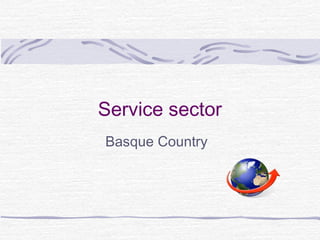
Tertiary sector in the basque country
- 2. Introduction Nowadays this is the most important sector During the last decades this sector occupes about half the active population or even more.
- 4. Introduction The reasons for the development of this sector are: Industrial crisis: many workers passed from the industry to the services Entrance in the EU: they needed to accommodate to the EU’s policy Autonomic process: public sector has developed a lot.
- 5. Transports Communications are not easy due to the relief Huge inversions have been required There are the link between the Peninsula and Europe Road transport has substituted the railway.
- 6. Transports : Routes The modern net is developing constantly The main roads are: Bilbao-Behobia motorway N-1 Madrid-Irun, it is the spine of the transports.
- 8. Transports : Railway There are two kinds: Wide width: the one linking with the Meseta Narrow width: it has fulfilled the needs of the industry The direct link between the Basque capitals is scarce The capitals will be linked with the High Speed Train, the project known as the Basque Y.
- 10. Transports : Sea transports It is essential for commercial relations with foreign countries The main ports are Bilbao, Pasajes and Bayona Bermeo’s port is important as a fishing one.
- 11. Transports: Air transports There are five airports: Loiu, Foronda, Biarritz, Hondarribia and Noain Loiu is the most important The main problems are relief and weather conditions.
- 12. Tourism It has not been too important in the economy in general Weather has influenced beach tourism The most important places are: San Sebastian Biarritz Nowadays the Basque Autonomous community is the second one in Biscay’s Gulf considering the number of tourist and the number of nights they spend in the region.
- 13. Tourism The hotels’ offer tends to concentrate in capitals This tourism is normally linked to two activities: Business and commercial relations Free time: Landscape Art Culture Gastronomy
- 14. Tourism The most traditional places are: Coast of Lapurdi (Biarritz was the precursor) Guipuzcoan coast (tourists of medium-high level) Biscay’s coast (Basque people tend to visit these places).
- 15. Tourism Rural tourism is developing: Attractive: Natural environment Art and culture accessible Rural houses are cheaper than hotels Many “baserris” are being adapted.
- 16. Tourism Navarre: Santiago’s Route is the main line: monuments dating back to the Middle Ages Rural tourism houses have developed a lot during the last years.
- 17. Tourism In the Basque Autonomous Community the following factors have influenced: Green tourism is attractive for those looking for a not too warm climate but in contact with nature Progressive introduction of Basque products in all the programmes of different business.
- 18. Tourism One of the aims is to recover professional tourism, at once with the economic development Increase of foreign and Spanish tourists’ number Publicity campaigns launched in different media to promote our region (Pais Vasco, ven y cuéntalo) One problem for tourism was the lack of political stability, quite forgotten nowadays.
- 19. Tourism New possibilities of tourism (summary): Rural tourism: peasants and livestocks’ owners offer touristy services Ecotourism: it takes advantage of the attractive of natural landscapes, natural parks and protected areas Congress and fairs: with new infrastructures (Euskalduna, Kursaal) Cultural: Guggenheim museum is the token of this kind of tourism.
- 20. Tourism Segments that have increased: Business and congress Rural tourism Coastal tourism Origin of tourists: Catalonia and Madrid Aragon and limiting communities Foreigners (Guggenheim effect)
- 21. Commerce Commercial structure has not evolved too much Modern forms are reserved to new regions The most developed big commercial centres the bigger crisis for retail commerce.
- 23. Commerce Finances backed industries and thanks to this: Big private banks: BBV Public saving banks: Kutxa Services for business.